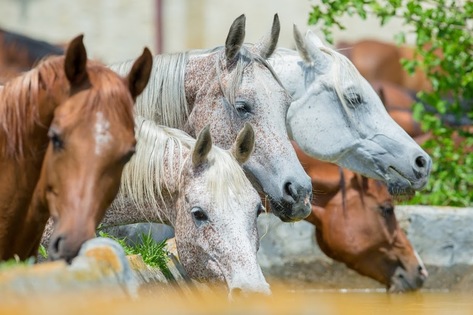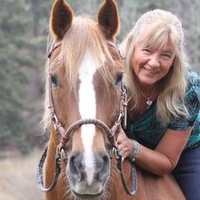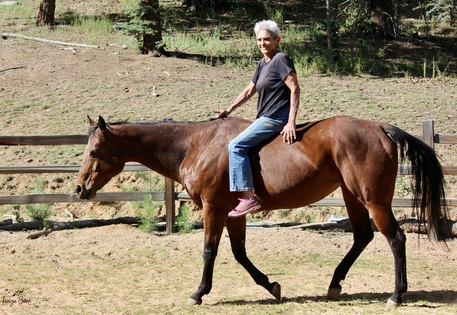
The Most Popular Horse Breeds Of 2019
Equestrian Advice & Guides General Equestrian
Build your business profile for FREE and expose your services to thousands of potential clients!
Create my profile now!
Ever watch someone riding with no bridle or saddle and wish you could do that with your own horse? The sheer magic of the horse-human relationship is never more clear than when both parties are in complete harmony doing whatever maneuvers they are performing.
This joining of minds is reminiscent of the movie “Avatar,” where the hair of rider and the dragon-beast are braided together so that their minds meld and yet, it is the rider who dictates where they go. Since we can’t braid our hair into the manes of our horses and end up with this fabulous and magical connection, how do we learn to ride our horses with no/little tack? Or even with no bit? Can you accomplish this with your own horse? Of course you can! It’s not impossible, and it’s not complicated. Bonus: You become a better rider, trainer and horse person by doing so!
I find it easiest to teach people to ride with no tack by beginning with them becoming completely at ease and comfortable riding bareback. Even if their goal is to simply ride bit-less, learning to ride using body and mind as their primary aid increases the communication level between horse and rider. By the time we remove the bit, or even the bridle, the transition is smooth and easy for both horse and rider.
Because training your horse always begins with training yourself, here’s how to begin riding with no saddle if you are not competent as a bareback rider. It is good to remember that all interaction with our horses begins with our intent to do the best we are able and to help foster a willing attitude from our horse. Ride and handle your horse from your mind first, then your body. This means connecting to him on his level, not yours. Listen with your eyes by watching his reactions before riding; is he tense or relaxed, paying attention or distracted? Get his attention focused on the fun you are having and remember to take the time you need to reach each goal you set for the both of you.
The best tip I can offer is for you to learn to ride well, is to teach yourself to lower your center of gravity. You need to drop it from your shoulders—where our innate center of balance is—down and into your hips and lower back. You can practice this by doing a little game I call “Shake Your Booty.” It is one of the most fun lessons we do in training the new rider to grasp the meaning of independent seat and hands. If you can, get a friend to join you and you’ll laugh more than you expect!
To play, start by watching yourself in a mirror while listening to some music you enjoy. You’ll be standing straight, feet hip-width apart, while maintaining square and still shoulders. As in belly dancing, you will move your hips while keeping your upper body straight. Once you have that down, walk, dance, jump and practice moving your lower body only, until you feel comfortable doing so. Stairs or bleachers are good to practice on as are boards set on the ground that you can learn to lower your center of balance on without using your arms. Remember that holding imaginary reins helps you to learn muscle memory for when you are on your horse.
When you are ready, get your horse and saddle him if you are not able to comfortably ride bareback while sitting the trot.
Once you can easily sit the trot bareback, add a neck rope that ties around the base of his neck with 4-6 inches slack when you pick it up from his withers. Be sure that there is no metal snap gouging either of you. A plain one-inch cotton rope is best since nylon ropes can burn both of you due to friction. Go back into the arena, and practice riding with no reins. You’ll have them, of course, they’ll be laying across his withers. If this is too much to tackle, keep your horse saddled and bridled as usual, but add the neck rope.
Riding with no reins means that all your bareback work is now paying off! You have learned to feel each other and each of you is able to anticipate what is coming. For your horse, he now knows the subtle shift of your body before you ask for either an upward or downward transition. What this breaks down to is knowing that each cue and command is preceded by micro-cues that you may not be aware of, but that your horse knows after only a few rides. A better breakdown is included in another blog post here: https://www.horseclicks.com/community/advice/equestrian/stop-n-go-101
Okay, back to the steps needed to get to bit-less and bridle-less riding. Your goal is to communicate with your horse through your body language, not your voice and with your legs, not your tack.
Once you are comfortable riding with no reins, it’s time to go bit-less. You’ll need to research what method of no-bit you will like best, so ask around, check reviews, dig up all pros and cons of the bridle you’d like to move onto. A few popular options are to use a rope halter and add reins. These are inexpensive and easy to try, but long term, you may not want something this harsh. The knots are strategically located to correspond to facial nerves on a horse’s head, and for this reason, they are not my favorite. I don’t tie or haul a horse in this kind of halter, but rather use them as correction aids and then, only temporarily.
Side pulls are a glorified halter in reality. Not much to them, but they usually have a leather or rawhide nose band that has metal rings on either side to hook reins too. They can be used with either a leather chin strap or a curb chain if a little more “bite” helps your horse respond easier. Sometimes a curb chain is preferred by riders on trail horses to prohibit unwanted snatching of grasses.
Dr Cook’s bridles are popular as well. These work by criss-crossing under the bars of the jaw and kind of squishing the horse’s face. I have found that most horses, not all, but most, become defensive in this bridle and begin to hollow out their backs and raise their heads to avoid the discomfort. I’d recommend these for horses who also go bridle-less easily and whose riders seldom use the reins.
Mechanical hackamores come in many forms, but basically, they have a leather nose band and metal shanks of various lengths. The shorter the shank, the less leverage and therefore, the more mild. These bits have no mouthpiece, but do have either leather chin straps or curb chains. Some horses prefer this bridle over a side pull and may have a little more responsiveness to it.
Bosals are teardrop shaped braided rawhide nose bands that are generally used when starting a horse in the vaquero tradition. These bridles are not for riders whose hands are not quiet and steady as they can cause raw and open sores when used incorrectly. For this discussion, this is the bridle I’d not suggest unless you are a trainer or a vaquero who knows how to properly implement usage.
There are so many brands, types and opinions that I feel the best thing you can do when deciding on one is to borrow, try and ask your horse what his preference might be; and trust me, you’ll know! My own horses prefer a side pull with a leather chin strap that is set high enough on their faces so as to avoid the soft cartilage near their nostrils. I like the chin strap loose enough that I can fit two fingers in between it and the bars of the jaw. My Arab mare that I recently lost went fine in a side pull, but she much preferred a short-shank mechanical hackamore. Why? I have no clue, maybe she wanted more bling? She’d go in anything, as will my geldings, but they do show a preference to one over another, so I go with that.
When working with client’s horses, I usually begin with a side pull and may even use in combination with a snaffle to help youngsters make the transition from halter to bit. On my own, I sometimes never take them out of the side pull since I no longer show. I have found that training, even up to mid-level dressage is doable in a bridle that has no bit. It comes down to personal preference, riding ability and desire for each equestrian to decide what bridle is best for their horse and themselves.
As always, if you have any questions or comment, feel free to contact me directly at info@TanyaBuck.com and may your love of the horse live on Happily Ever After!
~Tanya Buck
Free stuff here: TanyaBuck.com

